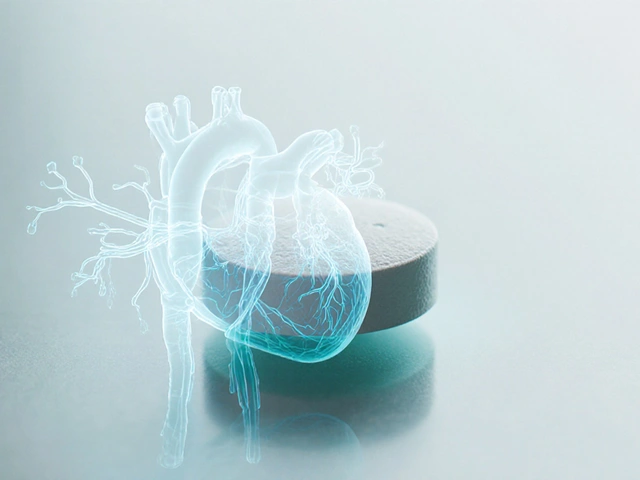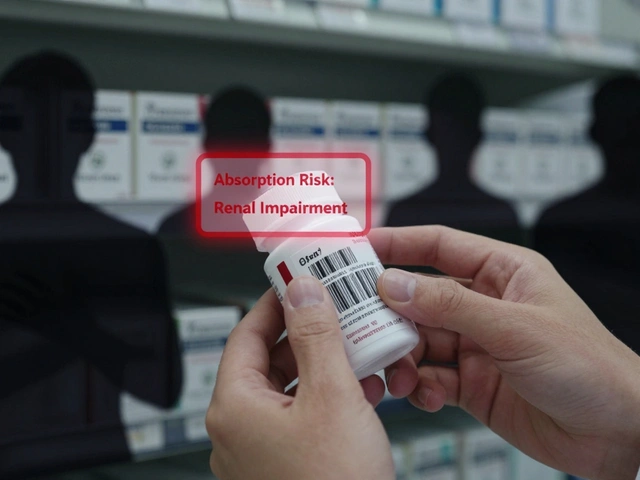Bone problems don’t wait until you hit retirement—my own parents were shocked to discover thinning bones in their early fifties. You never really pay attention to this stuff until one day you hear a crack after someone slips or you see a friend dealing with a painful hip fracture. Suddenly, pills like Fosamax start sounding less like a commercial and more like a real lifeline. But what exactly does this medication do for your bones, and what’s the catch?
How Does Fosamax Help Your Bones?
Fosamax is the brand name for alendronate, a bisphosphonate. It isn’t something you just pick up for fun—it’s prescribed to stop osteoporosis in its tracks. This drug works by basically telling your body’s bone-breaker cells (the osteoclasts) to chill out, while giving your bone-builder cells (osteoblasts) more time to work. Sounds like a simple switch, right? Not exactly. The balance between breaking down old bone and making new bone is tricky, and sometimes your body gets it wrong—usually as we age, but sometimes much earlier due to menopause, certain meds, or even family genes.
Doctors usually turn to Fosamax when they spot signs that your bones are losing density faster than they should, or if you’ve already had a fracture that seems suspicious. The main point is to help your bones regain strength so you can avoid those “fragility fractures” that can turn a minor fall into a big deal. You take Fosamax once a week or daily, always on an empty stomach first thing in the morning, with a full glass of water. Then—you wait. No coffee, no food, no lying down for 30 minutes. Why? The way alendronate is absorbed is super picky. Skipping these steps makes the pill way less effective, and messes with your esophagus. Actually, this last part freaks some people out: if you lie down or eat too soon, you risk the pill getting stuck, which can seriously irritate your throat.
Who actually benefits from Fosamax? Typically, women past menopause are the main group, since estrogen drop kicks off rapid bone loss. But men get it too, especially those on steroids or going through hormone-blocking therapies. There’s growing use for people with certain cancers, like prostate or breast cancer, since the meds they’re on can eat away at bones. For kids, it’s really rare and must be monitored closely by specialists.
One thing to know: the results aren’t overnight. Most folks need at least 3–6 months before you and your doctor see a shift in your bone mineral density scan (DEXA). Even then, you have to stick with it—bone rebuilding is a marathon, not a sprint. If you stop taking Fosamax abruptly, your bone breakdown speed can ramp up again, putting you back at risk. Compliance is the key. I know from watching my own mom struggle with remembering her pill routine—it’s easy to slip up with all the weird instructions, but the pay-off is fewer painful breaks, which is worth fighting for.
This med is usually recommended for a set period—often five years—before taking a “drug holiday” or switching up therapy, depending on your specific risk. Your doctor will likely run annual DEXA scans and check certain blood levels to track your progress. Fosamax isn’t a forever drug for most people; the risks and benefits get reevaluated regularly. That’s actually a relief for most of us who don’t want to take a pill forever unless it’s critical.
Fosamax Side Effects: What to Watch Out For
If you’ve ever read the fine print on a medical leaflet, you know it can sound scarier than the disease itself! Fosamax has its fair share of possible side effects, though most people do fine on it. Still, you should know what can go sideways. The most common thing you’ll hear about is stomach irritation. Heartburn, pain when swallowing, and even esophagitis get top billing. That’s why the instructions are so strict about how you take it. One wrong move and you could be dealing with a raw, angry throat for weeks. If you ever have pain in your chest, trouble swallowing, or new severe heartburn, call your doctor immediately.
There’s also the risk of low calcium in your blood. Since Fosamax changes how your body manages calcium, you have to make sure you get enough in your diet (dairy, leafy greens, or supplements if needed) along with vitamin D. Weirdly, not everyone knows this when they start—if you’re not getting enough calcium, the drug doesn’t do its job and can even make you feel weak or give you muscle cramps. My neighbor, an older guy who thought cheese was “for kids,” wound up hobbling around for weeks before his doc realized his calcium was low.
Then there are rare but headline-grabbing side effects. Osteonecrosis of the jaw (ONJ) sounds like something from a medical horror movie. This means jawbone death, and it’s serious, but almost always happens in folks with major dental work while taking high-dose bisphosphonates for cancer. For your average osteoporosis patient, the risk is extremely low—as in less than 1 in 10,000. Still, it pays to tell your dentist if you’re on Fosamax and keep your mouth clean. The American Dental Association says,
"the risk for ONJ with oral bisphosphonates like Fosamax in osteoporosis treatment is very low, but dental professionals should always be in the loop."
Another super rare problem: atypical thigh fractures—yep, sometimes people on long-term therapy get breaks in the middle of their thigh bone, without a big trauma. It sounds backwards, but it’s real, and doctors are much more aware now. That’s one reason why they don’t leave you on Fosamax forever. Watch for any new thigh pain and bring it up right away. As for allergies, those are rare, but don’t ignore a rash, facial swelling, or trouble breathing.
Then there’s just the daily annoyances—joint pain, muscle aches, sometimes flu-like symptoms the first time you take it. Usually, these get better as your body adapts. Most people can take Fosamax safely for years, but knowing the signs of trouble lets you use it confidently without surprise scares.

Daily Life With Fosamax: Tips for Success
If your doctor prescribes you Fosamax, it’s not just about swallowing a pill; it’s about changing some everyday routines. After helping my mother remember all the simple, but crucial, steps, I realized a checklist goes a long way. Here’s the big one: always take Fosamax after you wake up in the morning—don’t eat or drink anything first (except a tall glass of plain water, not tea, not juice). Swallow the pill whole, don’t chew or suck on it. Set a timer and stay upright—read the news, scroll your phone, but don’t lie down, eat, or drink anything else for 30 minutes. If you get this sequence right, most issues are avoided.
- If you miss a weekly dose and remember the next morning, take it, but skip if it’s closer to the next week.
- Don’t double up doses.
- Take your calcium and vitamin D later in the day to avoid blocking the medicine’s absorption.
Setting up reminders matters. Phones, sticky notes, whatever works for you or your family. I set a daily alert for my mom and sometimes, even my daughter chimes in to remind grandma. “Grammy, did you take your bone pill?”—no app is better than a motivated grandkid.
Also, be open with your healthcare team. Dentists, family docs, pharmacists—you want everyone on the same page. If you’re scheduled for dental surgery or a tooth get pulled, your doctor might pause Fosamax for a bit. This step makes sense since dental work is the one time your mouth is at higher risk for those gnarly jaw problems.
Stay on top of your nutrition game. Make sure you load up on calcium and vitamin D—either with food or supplements your doctor cleared. Avoid high doses of iron or magnesium at the same time as your Fosamax; they mess with absorption. If you’ve got severe kidney issues, talk to your nephrologist first. (Kidney disease can change how you process the med.)
Exercise is good for your bones—weight-bearing activities like walking, light jogging, or resistance bands. They help the drug do its job even better. My own trick? Family “bone walks”—my kids Elio and Iris love making it a game. Moving your body helps grow stronger bones alongside your medicine. No need for marathon runs—just regular, simple activity does the trick.
The Science and the Future: What’s New with Fosamax?
When Fosamax first hit the market in 1995, it totally changed how doctors managed osteoporosis. Before that, there weren’t many options besides hormone therapy, which came with its own risks. Since then, research has unpacked both the big benefits and the less obvious quirks of this drug. The backbone of Fosamax use is the DEXA (dual-energy X-ray absorptiometry) scan, a painless test that can actually tell you if your bone density is improving or slipping. This info guides your treatment—if you’re seeing improvements, you keep going. If your bones are still weakening, your doctor may adjust your plan or run tests for other hidden problems.
Studies published as recently as late 2024 keep showing that fosamax cuts the risk of hip and spine fractures by up to half in high-risk adults—especially in women over 65, those taking long-term steroids, and men with prostate cancer therapies. But the science isn’t done. There’s ongoing research into just how long people should stay on it, what happens if you take breaks, and whether combining it with newer meds speeds up bone growth. Some clinics are trialing using digital pill dispensers to decrease missed doses and using blood markers to more precisely guide therapy length.
There’s also work on personalized bone treatments—genetic testing that one day might predict who’s at higher risk for side effects or who will benefit the most. Right now, guidelines recommend reassessing the need for Fosamax every 3–5 years, since the benefits stick around for a while even after you stop.
If you’re wondering about alternatives, there are other bisphosphonates, as well as newer drugs like denosumab or parathyroid hormone analogs. They each come with their own pros and cons, costs, and methods of administration (some come by shot, not pill). The point is, if Fosamax isn’t the best fit for you, don’t panic—ask your doctor about options.
The world of bone health is moving fast, with technology and science working together to find better answers. Fosamax, with its long track record, is still a top pick for tackling osteoporosis, but now you can go to your next appointment armed with the facts that actually matter in daily life. If you or your family is facing a bone health scare, knowing how to make your medicine work better and avoid nasty surprises makes the journey a whole lot easier.











David Stephen
18 Jul 2025 at 10:35This article is a solid breakdown of Fosamax, very helpful especially for someone new to osteoporosis medications. What really stands out to me is the focus on clear information without overwhelming medical jargon. That makes it so much easier to understand the benefits and potential risks of alendronate.
I appreciate the part about safe usage tips — those details often get overlooked but can make a huge difference in treatment effectiveness. It’s also good that it covers the side effects; knowing what to expect helps patients stay informed and vigilant.
For anyone starting on Fosamax, I’d say teaming up with your doctor to track bone density changes over time is crucial. This way, you ensure the treatment is working and adjust if needed. Has anyone here had personal experience with Fosamax? Would love to hear thoughts on how it impacted your bone health journey.